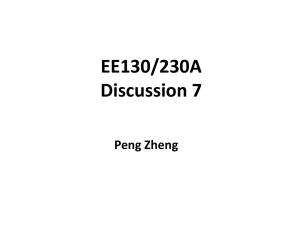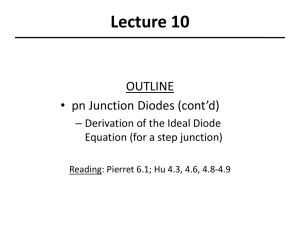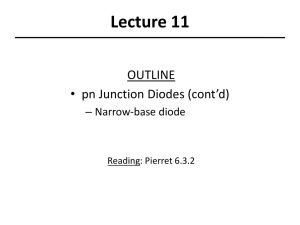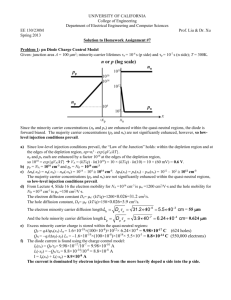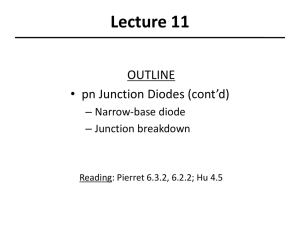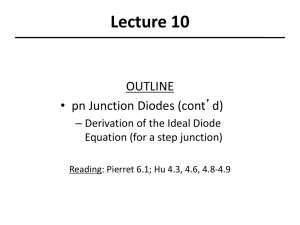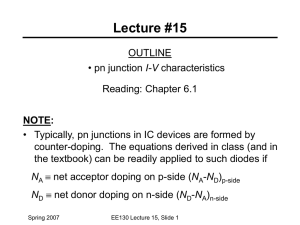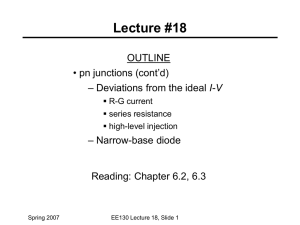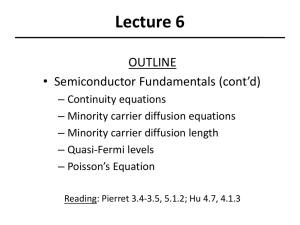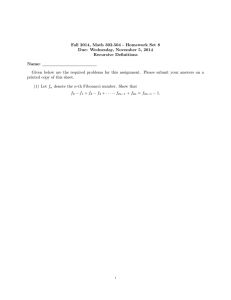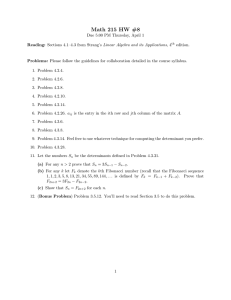EE130/230A Discussion 6 Peng Zheng
advertisement
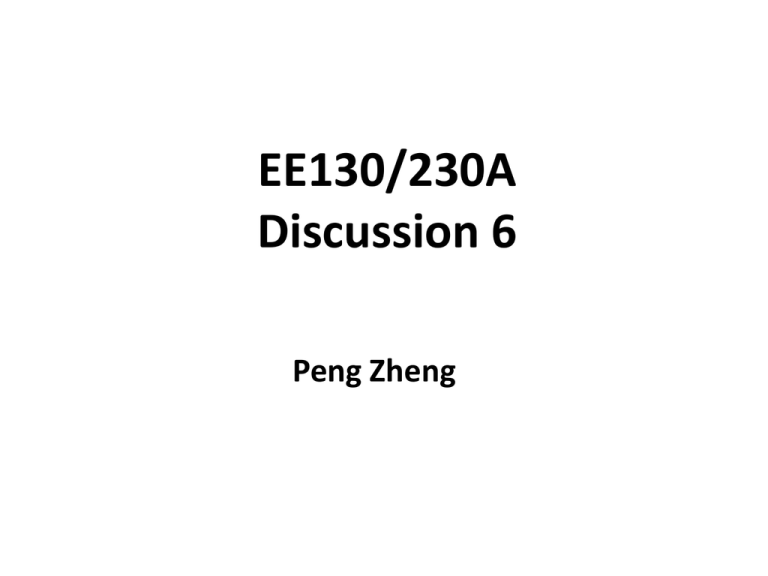
EE130/230A Discussion 6 Peng Zheng Carrier Action under Forward Bias • When a forward bias (VA>0) is applied, the potential barrier to diffusion across the junction is reduced – Minority carriers are “injected” into the quasi-neutral regions => Dnp > 0, Dpn > 0 • Minority carriers diffuse in the quasi-neutral regions, recombining with majority carriers EE130/230A Fall 2013 Lecture 10, Slide 2 Components of Current Flow • Current density J = Jn(x) + Jp(x) dn d ( Dn ) J n ( x ) qn n qDn qn n qDn dx dx dp d ( Dp ) J p ( x ) q p p qD p q p p qD p dx dx • J is constant throughout the diode, but Jn(x) and Jp(x) vary with position: Example: p+n junction under forward bias: J JN JP -xp EE130/230A Fall 2013 Lecture 10, Slide 3 xn x Excess Carrier Concentrations at –xp, xn p side n side p p ( x p ) N A nn ( xn ) N D ni2 e qVA / kT n p ( x p ) NA ni2 e qVA / kT p n ( xn ) ND pn 0 e qVA / kT n p 0 e qVA / kT 2 i n Dn p ( x p ) e qVA / kT 1 NA EE130/230A Fall 2013 ni2 qVA / kT Dpn ( xn ) e 1 ND Lecture 10, Slide 4 Carrier Concentration Profiles under Forward Bias EE130/230A Fall 2013 Lecture 10, Slide 5 R. F. Pierret, Semiconductor Device Fundamentals, Fig. 6.8a Excess Carrier Distribution (n side) • From the minority carrier diffusion equation: d 2 Dpn Dpn Dpn dx 2 Dp p Lp 2 • We have the following boundary conditions: Dpn () 0 Dpn ( xn ) pno (e qVA / kT 1) • For simplicity, use a new coordinate system: NEW: x’’ 0 0 x’ • Then, the solution is of the form: Dp ( x' ) A e x '/ Lp A e x '/ Lp n 1 2 EE130/230A Fall 2013 Lecture 10, Slide 6 Dpn ( x' ) A1e x ' / Lp A2e x ' / Lp From the x = boundary condition: From the x = xn boundary condition: x ' / Lp , x' 0 x ''/ Ln , x' ' 0 Therefore Dpn ( x' ) pno (eqVA / kT 1)e Similarly, we can derive Dn p ( x' ' ) n po (e EE130/230A Fall 2013 qVA / kT 1)e Lecture 10, Slide 7 Total Current Density p side: dDn p ( x' ' ) J n qDn dx' ' Dn q n p 0 (e qVA Ln Dp dDpn ( x' ) qVA n side: J p qD p q pn 0 (e dx' Lp J J n x x J p p x xn J n x0 J p Dn D p qVA J qn ( e Ln N A Lp N D 2 i EE130/230A Fall 2013 Lecture 10, Slide 8 kT x 0 1) kT 1)e x '' Ln kT x' Lp 1)e Summary: Long-Base Diode • Under forward bias (VA > 0), the potential barrier to carrier diffusion is reduced minority carriers are “injected” into the quasi-neutral regions. – The minority-carrier concentrations at the edges of the depletion region change with the applied bias VA, by the factor e qVA / kT – The excess carrier concentrations in the quasi-neutral regions decay to zero away from the depletion region, due to recombination. Dn D p qVA pn junction diode current I qAn (e Ln N A L p N D 2 i kT • I0 can be viewed as the drift current due to minority carriers generated within a diffusion length of the depletion region EE130/230A Fall 2013 Lecture 10, Slide 9 1) General Narrow-Base Diode I-V • Define WP‘ and WN’ to be the widths of the quasi-neutral regions. • If both sides of a pn junction are narrow (i.e. much shorter than the minority carrier diffusion lengths in the respective regions): DP DN qVA / kT qVA / kT I qAni e 1 I0 e 1 WN N D WP N A 2 e.g. if hole injection J into the n side is greater than electron injection JN into the p side: JP -xp EE130/230A Fall 2013 Lecture 11, Slide 10 xn x Summary: Narrow-Base Diode • If the length of the quasi-neutral region is much shorter than the minority-carrier diffusion length, then there will be negligible recombination within the quasi-neutral region and hence all of the injected minority carriers will “survive” to reach the metal contact. – The excess carrier concentration is a linear function of distance. For example, within a narrow n-type quasi-neutral region: pno (e qVA / kT Dpn(x) 1) 0 xn location of metal contact (Dpn=0) x WN’ The minority-carrier diffusion current is constant within the narrow quasi-neutral region. Shorter quasi-neutral region steeper concentration gradient higher diffusion current EE130/230A Fall 2013 Lecture 11, Slide 11 Sample Problem Consider a Si pn step junction diode maintained at room temperature, with p-side and n-side dopant concentrations NA = 1016 cm-3 and ND = 21016 cm-3, respectively. (You may assume that each side is uncompensated.) The minority carrier recombination lifetimes are tn = 10-6 s and tp=10-7 s on the p-side and n-side, respectively. Applied bias VA is (kT/q)*ln(108) 0.48V. What if the n-side is a short base? The hole diffusion component of the diode saturation current is calculated using the short-base diode formula: I0,p = Aqni2Dp/(Wn’×ND) ref. slide 10
